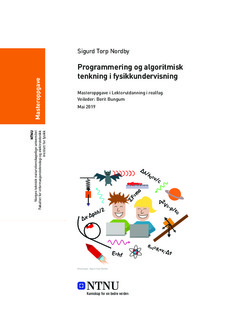| dc.description.abstract | Som et ledd i den norske regjeringens strategi for digitalisering av norsk skole, er det bestemt at programmering og algoritmisk tenkning («computational thinking») skal innføres i skolens matematikk- og naturfag. Det har dermed oppstått et behov for forskning om hvordan programmering bør integreres som et gjennomgående verktøy i undervisningen. Denne oppgaven har som formål å bidra til en god, gjennomtenkt innføring av programmering og algoritmisk tenkning i skolens fysikkfag på videregående nivå.
Forskningsarbeidet har hovedsakelig en kvalitativ tilnærming, og arbeidet som helhet har elementer av designbasert forskning. Problemstillingen undersøkes gjennom en litteraturstudie, en intervjuundersøkelse og utvikling og utprøving av undervisningsopplegg. I litteraturstudien gjennomgås allerede eksisterende forskning og erfaringer med programmering og algoritmisk tenkning i fysikk. I intervjuundersøkelsen undersøkes hvordan tre norske fysikklærere forstår begrepet algoritmisk tenkning og hvilke muligheter og utfordringer de ser for innføring av programmering som verktøy i fysikkfaget. Basert på dette er det utviklet tre undervisningsopplegg som er prøvd ut i tre forskjellige fysikklasser ved en videregående skole i Norge. Erfaringer om hvordan lærere og elever opplever undervisningen, er presentert basert på data fra observasjon og spørreundersøkelser.
Resultatene peker på at programmering og algoritmisk tenkning har en naturlig plass i det tjueførste århundrets fysikkundervisning. Å kunne programmere og forstå hvordan algoritmer fungerer er viktig for både arbeidsliv og allmenndannelse. Med programmering som verktøy kan elevene dessuten løse andre typer fysikkproblemer, som ellers ville vært for vanskelige. Det gir mulighet for større endringer i fysikkfagets form og innhold. Lærerne er i all hovedsak positive til programmering, og de ser muligheter for hvordan det kan inkluderes i fysikkundervisningen. Utprøvingen viser at elever uten programmeringserfaring fint klarer å arbeide med nokså avansert programmering i en fysikksammenheng. Lærerne er imidlertid noe bekymret for at programmering kan ta for mye tid, og at fysikkfaget vil bli enda vanskeligere. Undersøkelsen viser også at en del elever opplever undervisningen som svært utfordrende, og det er en fare for kognitiv overbelastning. Studien viser også at den norske oversettelsen av «computational thinking» kan være uheldig, fordi begrepets innhold kan misforstås av lærerne. | |
| dc.description.abstract | As part of the Norwegian government’s strategy for digitalization of the primary and secondary education in Norway, it has been decided that programming and computational thinking are going to be introduced through the mathematics and science courses. For this reason, there is a need for research on how programming should be integrated as a general tool in the education. The purpose of this thesis is to contribute to a good, thoroughly considered introduction of programming and computational thinking in the physics courses at upper secondary level.
The research has a mainly qualitative approach, and the work as a whole has elements of design-based research (DBR). The thesis statement is examined through a literature study, an interview study and development and testing of physics lessons with programming. The literature study reviews already existing research on programming and computational thinking in physics. The interview study examines how three Norwegian physics teachers understand the Norwegian term for “computational thinking” (which is literally translated “algorithmic thinking”), and what possibilities and challenges they see for introducing programming as a tool in the physics courses. Based on this, three lessons have been designed and tried out in three different physics classes at an upper secondary school in Norway. How teachers and students have experienced the lessons, is presented based on data from observations and questionnaires.
The results indicate that programming and computational thinking has a natural place in physics education of the 21st century. To programme and understand how algorithms work is important for both working life and general education. Moreover, with programming as a tool, students can solve a different kind of physics problems, that would otherwise be too difficult. This allows bigger changes in the curriculum. The teachers are largely positive about programming, and they see potential for how it could be included in the physics lessons. The try-out shows that students without former programming experience manage to do quite advanced programming in a physics context. The teachers are however somewhat concerned that programming may take up too much time, and that the courses will be even more difficult. The try-out also shows that some students experience the teaching as very challenging, and there is a chance for cognitive overload. The study further shows that the Norwegian translation of “computational thinking” might be unfortunate, as the concept could be misunderstood. | |
